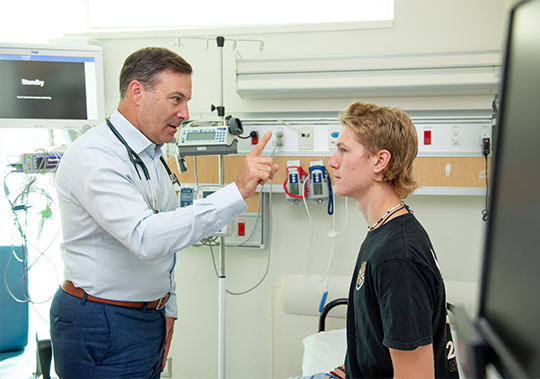‘The science didn’t know’: CHEO researcher fills gaps in concussion knowledge and care

Dr. Roger Zemek recalls sustaining three concussions as an athletic teenager. He suffered one of those concussions during the warm up before a baseball game.
As a pitcher, Dr. Zemek was on the mound loosening up his arm when a stray baseball, whizzing through the air, struck him in the head and knocked him unconscious. When he came around, his coach gave him a quarter to call his mother at a nearby pay phone.
“I dropped the quarter in the slot and couldn’t remember my phone number,” says Dr. Zemek.
He recovered from that concussion and the others without any long-term effects. But Dr. Zemek carries those experiences with him in his work as an emergency physician and one of Canada’s leading concussion experts at CHEO, a pediatric health care and research centre in Ottawa.
At CHEO, Dr. Zemek has built a concussion research program that has produced critical insights and informed evidence-based guidelines and tools to help health care providers, coaches, teachers, and parents manage the recovery of children and adolescents who suffer concussions.
Concussions are common head injuries among children and adolescents. They are most often caused by participation in sports, but they can also result from falls or accidents. The symptoms include headache, memory loss, confusion, fatigue, and sensitivity to noise. While most young people recover in weeks, a significant number experience symptoms that last months or years. The symptoms can have debilitating effects on mood, physical health, cognitive function, and performance at school or work. If symptoms persist beyond four weeks, the patient is considered to be experiencing persistent post-concussion symptoms.
Dr. Zemek’s research program is based on the principle that many heads are better than one. It means involving other researchers, clinicians, patients, and families every step of the way.
“My team was doing patient engagement before it became widely recognized as an essential part of research,” says Dr. Zemek. “The patients and families involved in our research program have made a significant contribution to our success.”
When the father of a teenaged boy who had just suffered his sixth concussion asked Dr. Zemek how long the symptoms would last, he didn’t have an answer. The science didn’t know.
Most concussion studies then were conducted with elite male football and hockey players. There were few if any studies on women, youth, or non-sport concussions. And there was no validated clinical tool to help physicians determine which patients were at risk of persistent symptoms.
So, Dr. Zemek got to work—and he invited the father of his patient to join him.
With the support of a CIHR planning grant, Dr. Zemek assembled leading Canadian and international experts and parents, and together they laid the groundwork for what would become the CIHR-funded 5P study: Predicting Persistent Post-Concussive Problems in Pediatrics. The goal was to derive and validate a prediction tool, known as a clinical risk score, to help physicians identify patients at risk of persistent symptoms.
Working with the Pediatric Emergency Care Network, Dr. Zemek and his team recruited more than 3,000 study participants aged 5 to 17—the largest cohort of its kind in the world—from nine pediatric hospitals across Canada. All participants had suffered a concussion within 48 hours of visiting the emergency department.
The prediction tool that Dr. Zemek and his team designed involves an assessment of risk factors for persistent concussion symptoms, including age, sex, medical history, previous concussions, the severity of symptoms, and the results of simple balance and vision tests. Each factor is assigned a point value depending on the characteristics and symptoms of the patient, adding up to a score on a 12-point scale. The higher the score, the higher the risk of persistent post-concussion problems.
By identifying who is at risk of persistent symptoms, physicians can create more effective recovery plans and monitor those patients more closely. For Dr. Zemek and other emergency physicians, the prediction tool helps them answer the questions parents ask most: How long will it take for my child to get better, and when can they safely go back to doing the things they want, need, or love to do?
Published in the Journal of the American Medical Association in 2016, the clinical risk score is now regularly used in pediatric emergency departments across Canada, resulting in children and adolescents with concussions getting the care they need and experiencing better outcomes and quality of life.
Since then, subsequent studies involving the 5P cohort have also advanced concussion research in other ways. Research led by Dr. Zemek’s team has shown that starting physical activity sooner and returning to school earlier improve recovery and health outcomes for youth with concussions.
At a glance
Issue
Concussions are common injuries among children and adolescents. While most young people recover quickly, about a third will experience symptoms lasting months or years that have a debilitating effect on their lives.
Research
CHEO’s Dr. Roger Zemek has developed a clinical risk score to identify young people who are at risk of developing persistent post-concussion symptoms. This prediction tool is helping ensure that those who may experience persistent symptoms get the specialized care they need.
- Date modified: